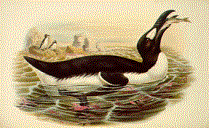Avicenna (/ˌævəˈsɛnə/; Latinate form of Ibn-Sīnā (Persian: پور سینا / ابن سینا; Arabic: ابن سینا), full name Abū ʿAlī al-Ḥusayn ibn ʿAbd Allāh ibn Al-Hasan ibn Ali ibn Sīnā[4] (Arabic: أبو علي الحسين ابن عبد الله ابن سينا; c. 980 – June 1037) was a Persian[5][6][7][8] polymath who is regarded as one of the most significant thinkers and writers of the Islamic Golden Age.[9] He has been described as the "Father of Early Modern Medicine".[10][11][12][13][14][15][16][17] Of the 450 works he is known to have written, around 240 have survived, including 150 on philosophy and 40 on medicine.[18]
His most famous works are The Book of Healing – a vast philosophical and scientific encyclopedia – and The Canon of Medicine,[19] an overview of all aspects of medicine[20][21] that became a standard medical text at many medieval universities[22] and remained in use as late as 1650.[23]
As well as philosophy and medicine, Avicenna's corpus includes writings on astronomy, alchemy, geography and geology, psychology, Islamic theology, logic, mathematics, physics and poetry.[24]
The system used by Ibn Sina placed principal importance on the first nine letters of the Arabic alphabet because it was believed these nine letters, known as the “Nine Letters of Adam,” were the primary instruments through which God first communicated to humans. These nine letters established a special hierarchy of relationships among the realms of creation.
All the other letters of Ibn Sina’s system were formed by adding or multiplying together the numbers corresponding to these first nine levels or states of being.
Here is Ibn Sina’s code:
A = 1 = al-Bari’: Creator
B = 2 = al-’aql: Intellect
J = 3 = al-nafs: Soul
D = 4 = al-tabi’ah: Nature
H = 5 = al-Bari’ (Bi’l-idafah): Creator in relation to what is below
W = 6 = al’aql (bi’l-idafah): Intellect in relation to what is below it
Z = 7 = al-nafs (bi’l-idafah): Soul in relation to what is below it
H = 8 = al-tabi’ah (bi’l-idafah): Nature in relation to what is below it
T = 9 = al-hayula’: material world having no relation to anything below it
Y = 10 = 5 × 2 = al-ibda’: the plan of the Creator
K = 20 = 5 × 4 = al-takwin: Structure transmitted to the created realm
L = 30 = 5 × 6 = al-amr: the Divine Commandment
M = 40 = 5 × 8 = al-khalq: the created Universe
N = 50 = M + Y = the twofold aspect of wujud (being)
S = 60 = M + K = the double relation to khalq and takwin
‘ayn = 70 = L + M = al-tartib: chain of being impressed upon the Universe
S = 90 = L + M + K = the triple relation to amr, khalq and takwin
Q = 100 = 2Y = S + Y = ishtimal al-jumlah fi’l-ibda’: The Asembly of all things in the plan of the Creator.



























